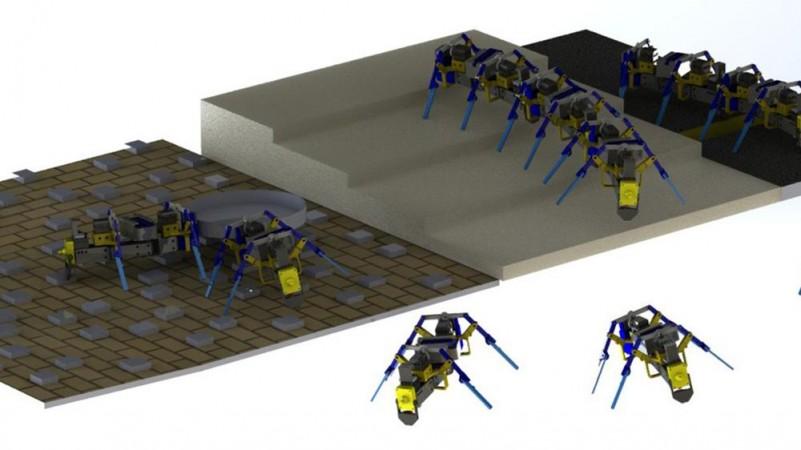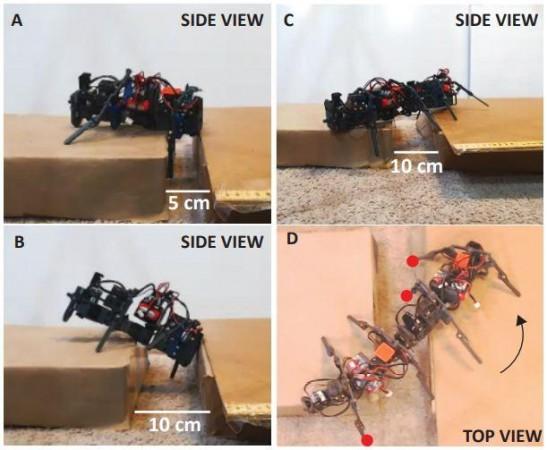Most futuristic science fiction movies are incomplete without a vital inclusion: robots. While humanoid robots are among the most commonly depicted ones, those bearing close physical and mechanical resemblances to animals often make it to the big screen. Sentinels—that work in perfect synchronization as a swarm—from The Matrix franchise are one such example. Now, scientists have reported the building of a new type of four-legged swarm robots.
In a study, researchers from the University of Notre Dame and Georgia Tech, have described new multi-legged robots with the ability to manoeuver difficult environments and accomplish challenging tasks collectively. The robots, which look like mechanical ants, were able to traverse across different environments and assist each other in the completion of tasks. The findings were published in the journal Science Robotics.
Inspired By Nature

While developing robots that emulate real animals such as Boston Dynamics' robot dog, Spot, engineers try their best to stay true to nature's original design. At the same time, the natural world also consists of animals such as ants, birds, and honeybees, who demonstrate flawless collective behaviours. Building small-scale swarm robots that can negotiate complex terrains like their real-world counterparts comes with its own set of challenges.
"When ants collect or transport objects, if one comes upon an obstacle, the group works collectively to overcome that obstacle. If there's a gap in the path, for example, they will form a bridge so the other ants can travel across — and that is the inspiration for this study," said Dr. Yasemin Ozkan-Aydin, lead author of the study, said in a statement.
For the research, the team hypothesized that the mobility of a terrestrial-legged collective system could be boosted by a physical connection among individual robots. Single robots can perform small or simple functions such as carrying a light object or moving across a smooth surface. However, if the task was beyond the capacity of a single unit to accomplish, the physically connected robots could form a bigger multi-legged system and overcome obstacles collectively.

"Legged robots can navigate challenging environments such as rough terrain and tight spaces, and the use of limbs offers effective body support, enables rapid manoeuverability, and facilitates obstacle crossing. However, legged robots face unique mobility challenges in terrestrial environments, which results in reduced locomotor performance," illustrated Dr. Ozkan-Aydin.
Building Swarm Robots
Dr. Ozkan-Aydin commenced work on the robots in early 2020 when the COVID-19 pandemic led to the shutting down of most of the US. Utilizing a 3D printer, she printed and built each of the four-legged robots—around 15 to 20 centimeters in length—individually. Each of the robots was fitted with a lithium polymer battery, a microcontroller, and three sensors.

The sensors comprised of a light sensor at the front end, and two magnetic sensors in the front and back, which enabled the robots to connect with each other. Through the use of four flexible legs, the reliance on extra sensors and parts was decreased. This provided the robots a level of mechanical intelligence that aided in interaction while navigating uneven or rough terrains.
"You don't need additional sensors to detect obstacles because the flexibility in the legs helps the robot to move right past them. They can test for gaps in a path, building a bridge with their bodies; move objects individually; or connect to move objects collectively in different types of environments, not dissimilar to ants," explained Dr. Ozkan-Aydin.
Navigating Different Terrains

With assistance from her son, Dr. Ozkan-Aydin carried out experiments with the 3D-printed robots at her home, her yard, and at the playground. The multi-limbed robots were tested over acorns, grass, leaves, mulch. For flat-ground experiments, she used particle boards, and utilizing insulation foam, she built stairs. Additionally, trials were conducted over shag carpeting.
For simulating rough terrains, rectangular wooden blocks were glued to particle boards. It was noted that when an individual robot faced difficulties or became stuck, a signal was relayed to additional robots. This resulted in them linking together to assist the aid-seeking robot to navigate the obstacles successfully, and most importantly, working collectively.
Scope for Improvement

The authors, however, admitted that the design requires further refinement. "For functional swarm systems, the battery technology needs to be improved. We need small batteries that can provide more power, ideally lasting more than 10 hours. Otherwise, using this type of system in the real world isn't sustainable," stated Dr. Ozkan-Aydin.
Other limitations included the requirement for more powerful motors and more sensors; all this while ensuring that the robots remain small-sized. Dr. Ozkan-Aydin averred, "You need to think about how the robots would function in the real world, so you need to think about how much power is required, the size of the battery you use. Everything is limited so you need to make decisions with every part of the machine."

Dr. Ozkan-Aydin hopes that the findings of the study will inspire the design of inexpensive multi-legged swarm robots. They may potentially be able to adapt to unplanned conditions and carry out real-world tasks such as space exploration, collective object transport, and search-and-rescue operations, among others.
The team intends to focus on enhancing the power, control, and sensing capacities of the system, which are crucial for locomotion and problem-solving in real-world situations. Dr. Ozkan-Aydin also wants to utilize this system to understand the collective dynamics of insects such as termites and ants.

















